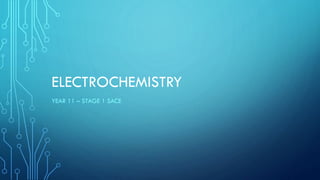
Electrochemistry
- 1. ELECTROCHEMISTRY YEAR 11 – STAGE 1 SACE
- 2. • In 1793, Alessandro Volta discovered that electricity could be produced by placing two dissimilar metals on opposite sides of a moistened paper. • In 1800, Nicholson and Carlisle, using Volta‘s primitive battery as a source, showed that an electric current could decompose water into oxygen and hydrogen. • By 1812, the Swedish chemist Berzelius could posit that all atoms are electrified, hydrogen and the metals being positive, the non- metals negative calling them ions
- 3. When a piece of zinc metal is immersed in pure water, the following occur: • Zn ions go in the solution leaving electrons in the metal • This continues till the level of electrons increase too much and the ions are unable to leave the metal anymore, hence, the process comes to a halt. Zn(s) Zn2+ + 2e–
- 4. When Zinc metal is immersed in Copper sulphate solution, the following things occur: • Zinc metal goes in the solution • Copper metal deposits on the Zinc metal • The blue colour of the solution starts disappearing. Zn(s) + CuSO4 ZnSO4 + Cu(s)
- 5. Activity Series of metals lists metals in descending order of its activity. A reactive metal displaces any metal in its ion form. React vigorously with acidic solutions to give H2 (dangerous) K React vigorously with liquid water to give H2 Ca Na React with acids to give H2 Mg Reacts slowly with liquid water but readily with steam to give H2 Al Zn Fe Ni Sn Pb H2 Do not react with acids to give H2 Cu Do not react with liquid water or steam Hg Ag Au
- 7. TERMINOLOGY • Electrochemical Cell (EC): A cell which converts chemical energy into electrical energy or vice –a –versa • Electrolytic cell: An EC which converts electrical energy in a chemical energy. • Galvanic (Voltaic) Cell: An EC cell used to convert chemical energy into electrical energy • Electrolyte: A compound when molten or dissolved has the capacity to conduct electricity and inturn gets decomposed. Depending upon the level of ionization, electrolytes can be called strong, weak or a non-electrolyte which does not ionize when dissolved in water.
- 8. • Electrode: A metal or Carbon rod which connects the electrolyte with a circuit. • Anode: The electrode where oxidation takes place • Cathode: The electrode where reduction takes place. • Electrolysis: A process in which electrical energy is used to produce a chemical reaction.
- 10. Voltaic (Galvanic) Cell Construction: • 2 half EC cells – in each cell a half reaction takes place. • Each half cell is made up of dipping a metal strip in its salt solution. E.g: Zinc metal strip dipping in a solution of Zinc salt. Copper metal strip dipping in a solution of Copper salt • The two half cells are connected with a salt bridge • The redox reaction is spontaneous but the electrons travel through an external circuit.
- 11. POINTS TO REMEMBER • Oxidation occurs at the Anode (-) Zn(s) Zn2+ + 2e– • Reduction occurs at the Cathode (+) Cu2+ + 2e– Cu(s) • Electrons generated by the reaction move through the external circuit. These electrons are used by the cathode for the reduction reaction • To maintain electron neutrality, cations move towards cathode and anions move towards anode. • The electrons always flow from the negative to the positive (i.e. anode to cathode)
- 12. NOTATIONS OF A VOLTAIC CELL • The anode is always written on the left, the cathode on the right. • The salt bridge is denoted by 2 vertical lines. • A single vertical line represents a phase change • E.g. Zn(s) Zn2+ (aq) Cu2+ (aq) Cu(s)
- 13. • When a gas is involved, then, an inert metal like platinum is used as an electrode, which just catalyses the reaction, does not actively participate in the reaction. • E.g. for cathode: H+ (aq) H2(g), Pt • For Anode: Pt, H2(g) H+ (aq)
- 15. CONSTRUCTION OF AN ELECTROLYTIC CELL • Electrolytic cell: An EC which uses electric current to cause a non – spontaneous chemical reaction • Consists of: • A battery (source of electron) • Electrolyte • electrodes
- 17. POINTS TO REMEMBER • When the charge is supplied electrons are drawn away from the Anode hence, anode becomes positively charged, attracting negatively charged ions • Electrons are supplied to the cathode hence becoming negatively charged, attracting positively charged ions. • Anode receives electrons, oxidises anions or water. • Cathode provides electrons, reduces cations or water
- 18. APPLICATIONS: • Extraction of metals from their compounds, e.g. zinc • Recharging a lead – acid battery. • Electroplating, e.g. nickel, chromium • Refining of metals, e.g. copper • Production of non – metallic elements, e.g. chlorine, hydrogen
- 19. MOLTEN ELECTROLYTES • Molten Electrolyte is defined as when the electrolyte is kept at a temperature higher than its boiling point. • For e.g. : Lead (II) Bromide. • Reaction at anode: 2Br- (l) Br2 (g) + 2e- • Reaction at Cathode: Pb2+ (l) + 2e- Pb(s) • Another example :NaCl
- 20. AQUEOUS ELECTROLYSIS • Reactions carried out in aqueous solution provide an added complication. Water ionises to produce hydrogen (H+) ions and hydroxide (OH¯) ions. These are often displaced from solution to give hydrogen gas and oxygen gas. Which ions are released depends upon the following factors: the position of the ions in the reactivity series. Concentration of ions in the electrolytes. Nature of the electrodes.
